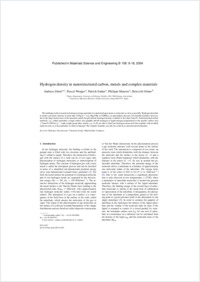Hydrogen density in nanostructured carbon, metals and complex materials
- Züttel, Andreas Physics Department, University of Fribourg, Pérolles, Switzerland
- Wenger, Pascal Physics Department, University of Fribourg, Pérolles, Switzerland
- Sudan, Patrick Physics Department, University of Fribourg, Pérolles, Switzerland
- Mauron, Philippe Physics Department, University of Fribourg, Pérolles, Switzerland
- Orimo, Shin-ichi Institute for Materials Research, Tohoku University, Sendai, Japan
-
16.03.2004
Published in:
- Materials Science and Engineering B. - 2004, vol. 108, no. 1-2, p. 9-18
English
The challenge in the research on hydrogen storage materials is to pack hydrogen atoms or molecules as close as possible. Hydrogen absorbed in metals can reach a density of more than 150 kg m⁻³ (e.g. Mg₂FeH₆ or Al(BH₄)₃) at atmospheric pressure. For metallic hydrides, however, due to the large atomic mass of the transition metals the gravimetric hydrogen density is limited to less than 5 mass%. Nanostructured carbon materials, e.g. carbon nanotubes or high surface area graphite absorb hydrogen at liquid nitrogen proportional to the specific surface area 1.5 mass%/1000m²g⁻¹. Light weight group three metals, e.g. Al, B, are able to bind four hydrogen atoms and form together with an alkali metal an ionic or at least partially covalent compound. The complex hydrides can only be cycled in as nanostructured materials.
- Faculty
- Faculté des sciences et de médecine
- Department
- Département de Physique
- Language
-
- English
- Classification
- Physics
- License
-
License undefined
- Identifiers
-
- RERO DOC 4241
- DOI 10.1016/j.mseb.2003.10.087
- Persistent URL
- https://folia.unifr.ch/unifr/documents/299718
Statistics
Document views: 182
File downloads:
- Texte intégral: 478
